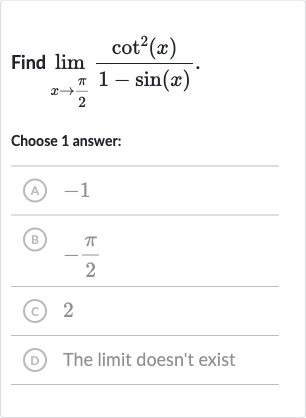Full solution
Q. Find Choose answer:(A) (B) (C) (D) The limit doesn't exist
- Understand Behavior of Function: First, let's understand the behavior of the function as approaches . The cotangent function, , is the reciprocal of the tangent function, , which means . As approaches , approaches infinity because the angle is approaching degrees where the tangent function is not defined. Therefore, approaches . However, we have in the numerator, which means we need to consider the square of as approaches .
- Evaluate Limit Indeterminate Form: Now let's look at the denominator, . As approaches , approaches . This means that the denominator, , approaches . We have a situation where both the numerator and the denominator are approaching , which is an indeterminate form. This suggests that we may need to apply L'Hôpital's Rule to evaluate the limit.
- Simplify Expression: Before applying L'Hôpital's Rule, let's simplify the expression if possible. The expression can be written as . So, the limit can be rewritten as:This is equivalent to:
- Apply L'Hôpital's Rule: Now we can apply L'Hôpital's Rule because we have an indeterminate form of . L'Hôpital's Rule states that if the limit as approaches of is or , then the limit is the same as the limit of the derivatives of the numerator and the denominator. So we need to find the derivatives of and with respect to .
- Find Derivatives: The derivative of with respect to is using the chain rule. The derivative of with respect to is , and the derivative of with respect to is . Therefore, the derivative of the denominator with respect to is .
- Apply Derivatives to Rule: Now we can apply the derivatives to L'Hôpital's Rule:We can simplify this by canceling out common factors of and where possible, keeping in mind that as approaches , approaches and approaches .
- Simplify and Substitute: After canceling out the common factors, we get:Now we can substitute into the simplified expression:\frac{\(-2\)}{\(2\) - \(3\)(\(1\))} = \frac{\(-2\)}{\(2\) - \(3\)} = \frac{\(-2\)}{\(-1\)} = \(2

